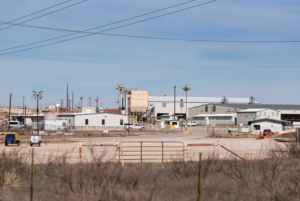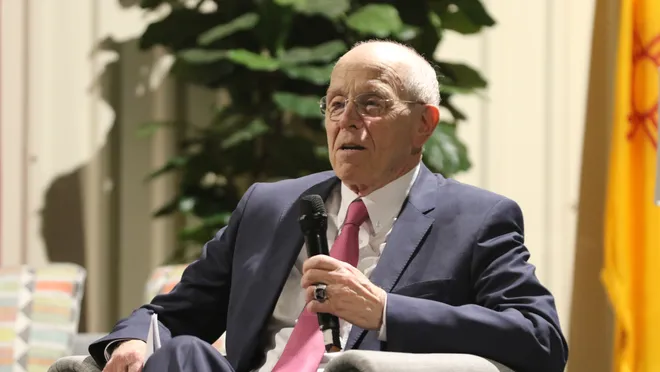 A hazardous waste disposal company in Andrews County wants to handle more dangerous levels of nuclear waste. Federal agencies are pondering new rules that could allow more of it to come to Texas.
A hazardous waste disposal company in Andrews County wants to handle more dangerous levels of nuclear waste. Federal agencies are pondering new rules that could allow more of it to come to Texas.
To get rid of eight gallons of water, the U.S. Department of Energy spent $100,000.
It’s little more than half a tank of gasoline in a midsize car, but the radioactive shipment from South Carolina to a West Texas company last fall marked one change that could lead to more nuclear waste traveling to Texas — waste that, until recently, was considered too dangerous to be disposed of.
Much of the public debate surrounding Waste Control Specialists’ hazardous waste facility in Andrews County, on the New Mexico border, has focused on the company’s plans, with a partner, to store the riskiest type of nuclear waste: the spent fuel rods from nuclear power plants, which can remain dangerously radioactive for hundreds of thousands of years.
Scientists agree that spent nuclear fuel should be stored deep underground, but the U.S. still hasn’t located a suitable site. Interim Storage Partners — a joint venture of Waste Control Specialists and Orano USA, a subsidiary of one of the world’s biggest nuclear power companies — proposed bringing the spent fuel to a 332-acre site next to the WCS facility in Andrews County until a permanent storage site is found.
If the plan succeeds, it would be a big expansion for Waste Control Specialists, which has been disposing of the nation’s low-level nuclear waste — including tools, building materials and protective clothing exposed to radioactivity — for a decade. Interim Storage Partners’ website says it expects to get the federal approval for spent nuclear fuel storage, a major step in the plan, this year.
The idea still faces significant legal hurdles and stiff opposition from environmental groups, local oil companies, some residents and Texas Gov. Greg Abbott, who wrote to federal regulators last year asking them to deny the license application, stating that the proposal presents a “greater radiological risk than Texas is prepared to allow.”
The federal government and the companies involved say radioactive spills during transportation or storage that expose people or the environment to radiation are very unlikely to occur, but opponents fear human error, mechanical failures or geological changes could result in groundwater contamination.
But while the slow-moving plan is wrapped in political turmoil, lower-profile changes and proposals from federal agencies are giving Waste Control Specialists another avenue to accept more radioactive waste than it does today.
The wastewater that traveled from an old South Carolina nuclear weapons facility more than 1,000 miles in three truckloads in late September was an example: It was the first shipment made after a 2019 U.S. Department of Energy decision to reinterpret how different levels of radioactive waste are classified, allowing it to be disposed of at a commercial facility.
The decision lets the DOE categorize waste based on its properties and hazard level rather than how it was created, and allows radioactive waste from nuclear weapons production and government-sponsored nuclear energy research to be shipped to commercial sites such as the one in Texas, rather than indefinitely stored at a government site.
“They did this eight gallons as a sort of test,” said Tom Clements, the director of Savannah River Site Watch, an advocacy group that monitors the DOE’s site in South Carolina, a nuclear national security complex where materials for nuclear weapons were produced until 1991 at the end of the Cold War. “It is the foot in the door to taking more material to WCS.”
And the federal Nuclear Regulatory Commission is also considering new rules that could give Waste Control Specialists a green light to pursue bringing more dangerous radioactive waste to its commercial facility than currently allowed by state law.
The company is already permitted to accept low-level nuclear waste in Andrews County. The plan to build a facility to store spent nuclear fuel, the most dangerous kind, would bring what’s considered high-level nuclear waste. In addition, NRC staff recommended in October that the agency consider allowing commercial facilities like WCS to accept materials that fall into a third danger level between those two categories.
“The floodgates may be opening [in Texas],” Clements said.
That’s exactly what many environmentalists and local opponents feared after the hazardous waste facility was built in 1995. At the time, a company official told the community that it had no plans to expand to radioactive waste disposal.
“This is one of the difficulties of a community or state agreeing to one type of waste facility, because it can be changed on you,” said Rodney Ewing, a scientist and professor in nuclear security at Stanford University. “If it’s judged to be safe, that becomes the rationale for accepting more waste.”
Waste Control Specialists and Interim Storage Partners executives repeatedly declined, through a spokesperson, to provide interviews or comment for this story, referring instead to company fact sheets. On their websites, the companies emphasize their commitment to safety and the environment. WCS states on a media sheet that the company “has an extensive monitoring program to ensure the safety of the community and the environment at all times.”
Nuclear debate in Texas
The nuclear power industry prides itself on operating no-emissions plants without burning fossil fuels like coal and natural gas, which create the greenhouse gas emissions that contribute to climate change. By locating in the Permian Basin, one of the most productive oil fields in the world, Waste Control Specialists has found itself in a political fight against fossil fuel interests that its customers often compete with.
Elaine Magruder is co-owner of an Andrews County ranch where her family has raised cattle and pumped oil since 1893. She’s also a member of a coalition of Permian Basin landowners and oil and gas operators that oppose radioactive waste storage and disposal in Andrews County. The coalition is led by Fasken Oil and Ranch, which owns thousands of acres in Andrews County.
Magruder says she’s worried that a transportation accident could expose local residents to radioactive material and disrupt oil and gas operations. She also worries that a leak at the facility could allow radioactive material to seep into the ground, contaminating area drinking water. The facility is near the Ogallala Aquifer of the Great Plains, which provides drinking water for millions in the West.
Elaine Magruder on her family’s ranch near Andrews, Texas on Jan. 17, 2021.
“What has to be considered is short-term economic gain for long-term disastrous risk. It has the risk of harming our whole Permian Basin area,” says Elaine Magruder, co-owner of a ranch in Andrews County. Credit:
Eli Hartman for The Texas Tribune
“[The oil and gas] industry has supported our families and communities for all this time,” Magruder said. “What has to be considered is short-term economic gain for long-term disastrous risk. It has the risk of harming our whole Permian Basin area.”
But Andrews County Judge Charlie Falcon said he supports the facility’s expansion plans. He believes the majority of the county’s 18,700 residents don’t object to Waste Control Specialists’ operation, which employs 110 people and pumps around $1 million annually into the county’s coffers through a 5% fee on all disposal activities — an amount that would likely increase if the facility is allowed to accept more radioactive waste. WCS has paid $13.4 million in fees to Andrews County since 2012. Another $59.3 million has gone to the state.
“Most people do not have a problem with the waste facility out there,” Falcon said. “WCS, the company, they are great corporate partners with the county and the schools. They do their part.”
A Department of Energy review of nuclear waste shipments worldwide found that there have been few transportation accidents involving spent nuclear fuel — and most were minor, according to the analysis. And as for other radioactive waste, the DOE, in a statement, said it safely ships hazardous waste via routes that minimize radiological risk.
The Nuclear Regulatory Commission also found in a 2014 assessment that federal regulations are adequate to ensure public safety during transportation of nuclear waste and that the chance of a radioactive release during an accident is very small.
Ewing, the Stanford University nuclear security professor, said the larger risk is environmental contamination due to the facility’s proximity to the aquifer — a concern shared by some other nuclear scientists and geologists.
This unlikely alliance of environmental groups and oil companies has Abbott on its side. In November, the governor sent a letter urging the Nuclear Regulatory Commission to deny the application for storing spent nuclear fuel in Andrews County, arguing in part that the proposed facility “imperils America’s energy security” by making the region an even greater possible terrorism target than it is today due to its oil and gas reserves.
Waste Control Specialists and its partners point to the area’s geological characteristics as the primary reason why the site is one of the safest places in the nation to put nuclear waste. The facility sits atop an impermeable 600-foot-thick red clay formation, and according to a Department of Energy environmental assessment, the hazardous and radioactive waste is buried in the clay and “encapsulated in a robust liner and cover system” to prevent leaks or spills.
Falcon, the county judge, said he sees radioactive waste as a buffer against the inevitable ups and downs of the cyclical oil and gas industry.
“If that is to dry up and go away, especially with a new administration that opposes oil and gas, we don’t have a whole lot of resources here for economic diversification,” he said.
Radioactivity in West Texas
Waste Control Specialists’ nuclear waste pursuit was the brainchild of now-deceased Dallas billionaire Harold Simmons, who slowly took over the company in the early 2000s as he became more invested in what was then a small hazardous waste disposal business in Andrews County.
Long before Simmons’ takeover, a Waste Control Specialists official was quoted in the Andrews County News in 1993 stating that the facility “would not take radioactive materials, nuclear waste, medical wastes, explosives or any liquids.”
But the company’s new owner soon began lobbying the Texas Legislature for permission to accept low-level nuclear waste at the facility. Simmons had clout at the Capitol: He was a major donor to then-Gov. Rick Perry. Even so, getting the permits for low-level nuclear waste, which typically includes a wide range of contaminated items such as radioactive gloves, shoe covers and medical tubes, took years of political maneuvering.
First, the Texas Legislature passed a bill making it legal for private companies to dispose of low-level nuclear waste in Texas — a bill that Perry signed into law in 2003. That sparked an intense effort to block the plans for low-level nuclear waste at the site by environmental groups and landowners who raised concerns over water contamination, transportation accidents and increased terrorist threat to the region.
Glenn Shankle, then the executive director of the Texas Commission on Environmental Quality, recommended the site be permitted to dispose of lower-level nuclear waste — defying some of the agency’s scientists who said nearby groundwater could be at risk.
A few TCEQ staff members resigned over the nuclear waste proposal, among them Patricia Bobeck, a geologist who said she was pressured by higher-ups to find a way to approve the permit, despite her professional opinion that the geology of the area was at a high risk of erosion — which could increase the chance of environmental contamination. Bobeck said she retired from government rather than “have that permit shoved down my throat.”
The director, Shankle, later took a job as a lobbyist for Waste Control Specialists.
Today, Elizabeth Padilla, a school teacher in Andrews and mother of four who opposes the facility because she worries it could pose health risks to her family, points to the 1993 Andrews County News article as proof of what she calls a broken promise to the community.
“The people of Andrews gave them an inch, and they’re wanting to take miles and miles,” said Padilla. “They just can’t have enough.”
A new interpretation
Even after getting permission to expand into nuclear waste, the company had high costs and not enough demand. Some nuclear energy industry experts theorized that expensive commercial nuclear waste facilities like WCS overestimated the amount of low-level nuclear waste that would need disposal as power plant operators became more efficient.
immons died in 2013, and WCS, in financial distress, was acquired in 2018 by J.F. Lehman & Co., a New York private equity firm that specializes in defense, maritime, environment and government industries.
By then, Donald Trump had become president and tapped Perry to head the Department of Energy, which is charged with finding a long-term solution to the nation’s high-level nuclear waste — much of it stored across the nation on site at the power plants where it was created and at DOE sites, for lack of anywhere else to put it.
In 2019, the DOE reinterpreted how it classified different levels of nuclear waste, basing each level on radioactivity and risk rather than by how it was created. It was a change that experts convened by the Secretary of Energy recommended in order to modernize the nation’s nuclear waste disposal process.
For example, some high-level waste was classified that way because it was created during weapons production, not because it is as long-lasting or dangerous as spent nuclear fuel. By reclassifying some of the government’s nuclear waste to a lower level, the DOE could move it to commercial facilities for disposal — including WCS’ Texas facility — and save the federal government more than $200 billion in waste storage and maintenance costs, the DOE estimated in a December report to Congress.
The entrance to the Waste Control Specialists site, where radioactive and hazardous waste is being stored on Jan. 17, 2021.
Waste Control Specialists stores radioactive and hazardous waste in Andrews County. Credit:
Eli Hartman for The Texas Tribune
Not everyone agreed with the new interpretation. The state of Washington, which has tangled with the federal government for years over contamination from a decommissioned nuclear complex, opposed the reinterpretation, concerned that the federal government would erroneously label dangerous waste as low level. Others criticized the DOE for failing to publicly reveal how much waste would be reclassified.
“They didn’t describe how much waste there would be, or how they would handle it,” said Don Hancock, an attorney and director of the Nuclear Waste Safety Program at the Southwest Research and Information Center in Albuquerque, New Mexico. “My expectation is that DOE itself doesn’t know exactly how much is in South Carolina that it wants to send to WCS.”
The DOE did not provide an estimate of how much waste the new interpretation would apply to, but stated that no decisions on implementation have been made beyond that eight-gallon shipment to Texas.
The agency said using the new classifications for the waste “enables the Department to better address one of our Nation’s largest environmental challenges” by allowing waste that has been stored at DOE sites for decades a new path for disposal.
“It’s not cotton candy”
Meanwhile, the Nuclear Regulatory Commission may soon consider new regulations that would allow WCS and other commercial sites to accept a higher level of nuclear waste than Texas currently allows.
The WCS facility is permitted to accept Class A, B, and C nuclear waste — categories that fall below high-level material like spent nuclear fuel. But certain material, much of it generated by the decommissioning of nuclear power plants, falls into what experts call a gray area between the lower-level categories and spent nuclear fuel. It has an equally ambiguous name: “Greater than Class C.”
The waste represents an opportunity for disposal companies, industry observers said, as more nuclear power plants are decommissioned in favor of cheaper natural gas power plants or renewable sources like wind and solar.
The “Greater than Class C” waste is currently considered “high level,” meaning it can only be slated for the ultra-secure underground storage in a permanent repository that the U.S. government has yet to create. In the meantime, it’s mostly stored where it was created.
But a 2014 request by Waste Control Specialists set off a discussion at the NRC on whether new guidelines for the “Greater than Class C” waste should be created. Because Texas law prevents commercial sites from accepting it, WCS asked state regulators to change the rules. The TCEQ needed to clarify with the federal government whether it was even allowed to regulate such high-level materials; now, the NRC is looking at the possibility.
NRC staff recommended in October that the commission consider rules to allow commercial sites to accept this category of waste, concluding that 80% of the “Greater than Class C” waste could be safely disposed of at facilities like WCS’ rather than deep underground. Staff wrote that the rule would provide a quicker solution to waste otherwise trapped on site, waiting for a permanent home that has yet to materialize, and that the materials are “not so hazardous” that they should only be managed by the federal government.
Some experts, however, are skeptical of changing the rules. Bob Alvarez, a nuclear waste expert and senior scholar at the Institute for Policy Studies, said he believes this category of waste is dangerous enough for long enough that it should be isolated in a geologic repository like the proposed Yucca Mountain facility in Nevada.
“These are some of the most dangerous materials in the world,” Alvarez said. “It’s not cotton candy.”
But even if NRC commissioners change rules to allow state-level oversight, it may not help WCS advance its plans. Abbott is opposed to bringing the “Greater than Class C” waste to Texas, according to his letter to the NRC. David McIntyre, a spokesperson for the NRC, said it’s not clear when agency commissioners will make a decision on the staff’s recommendations.
Opponents of the proposal say, either way, the company’s efforts to get permission to handle the waste represents another attempt to boost its profits by taking more dangerous waste.
“[It’s] an effort over many years to make it look less threatening, and to sneak it in as less hazardous,” said Karen Hadden, the executive director of the Sustainable Energy and Economic Development Coalition, a sustainable energy alliance of businesses and organizations. “[Waste Control Specialists] continues down this path of ever expanding their radioactive empire.”
Source: https://www.texastribune.org/2021/02/10/nuclear-waste-government-rules/




0 Comments